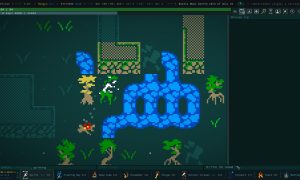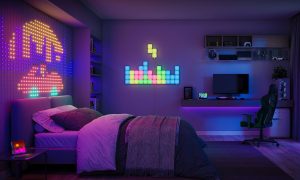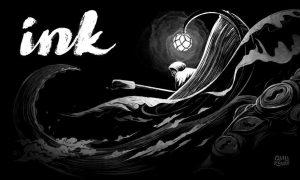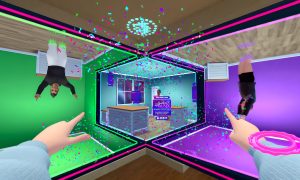I’ve had a long and contentious relationship with Zelda games. For years, the only Zelda game that I enjoyed was Link’s Awakening for the Game Boy, and that’s only because one of my friends held my hand throughout the entire game. In years since, I’ve tried understanding what the big deal is about Zelda as game after game left me cold. I’ve played each and every game in hopes that it’ll finally open the door. The good news? I can proudly report that in 2009 the heavens finally parted, trumpets blew and angels flew, allowing me to finally get what Zelda is all about. I’m a believer.
I’m glad I got over my general disdain for Zelda in time for Spirit Tracks, the latest iteration of the long-running series. When Spirit Tracks was announced, you heard something akin to the sound of a monocle dropping into a glass of cognac among the Zelda faithful. “A train? In ZELDA? Bring me my dueling pistols!” Add to that the lingering anger over Phantom Hourglass’ Temple of the Ocean King, and there was a recipe for disaster. How did Spirit Tracks fare? Is it worth picking up?
It’s Dangerous To Go Alone
While the train may look like Spirit Tracks’ major addition, it’s not as important as the other major addition: Zelda accompanies Link through this adventure. Due to an unfortunate case of death contracted at the beginning of the adventure, Zelda’s ghost travels alongside Link throughout. She can even inhabit Phantoms, those annoying hulking metal monsters that terrorized Link in the Temple of the Ocean King. This leads to some excellent puzzles that really take advantage of this technique.
Also, Zelda serves as a fantastic counterpoint to Link. Link is, of course, a silent protagonist. Most of his reactions are gasps, yelps or determined grimaces, so he’s not a really interesting guy on his own. Zelda, however is a chatty Cathy. She’ll say humorous things at certain points in your adventure or speak with characters in a way that Link can’t. It’s excellent, frequently hilarious, and much better than hearing “Hey! Listen!” every few minutes.
It’s A Secret To Everybody
The dungeons are where Spirit Tracks shines. They only give you a few different weapons, but every weapon remains in play throughout the entire game. That leads to some really devious puzzles that make you put things together in a way that you may not otherwise have done, and they’ll sometimes challenge you to chain a series of solutions together in way that you wouldn’t have expected. They’re almost worth the price of admission on their own. Also, for those who played Phantom Hourglass, the controls in Spirit Tracks should be instantly familiar. It controls almost identically with a few tweaks to the stylus controls. They’re very solid and accurate, and with very few exceptions, do exactly what you expect them to.
However, as great as the dungeons are, I have a few complaints. First, there are only five main temples. What happened to the days when we would have eight full-featured dungeons? It’s not right when games like Link’s Awakening and the Oracle of Ages/Seasons games were able to have eight unique dungeons while a modern handheld Zelda only has five.
“Well, Mr. Reviewer Man, you’re just not counting the dungeons in the Tower of Spirits. That’s your problem right there.” True, when you revisit the Tower of Spirits, which serves as the hub for Spirit Tracks, you’ll find what amounts to six more dungeons. While that addresses game length, a couple of problems spring to mind.
First, I like a little variety in my dungeons, and while we have the Fire Temple, Ice Temple, Forest Temple, Ocean Temple and Sand Temple along with a Dark Realm, those are some pretty well-travelled areas. I mean, which Zelda game DOESN’T have these dungeon themes, let alone most RPGs?
Also, what’s with Nintendo’s latest obsession in handheld games of having us navigate the same temples/towers over and over again? They did it with the Temple of the Ocean King in Phantom Hourglass and now they’re asking us to revisit the Tower of Spirits. Every level of the Tower of Spirits has Phantoms running around, every level looks the same and has the same general theme, so it just feels like one really long dungeon stretched out throughout the course of the game. Granted, you don’t have to march through the same areas that you’ve beaten before, but you’re still coming back to the same region over and over.
It’s a testament to the skill of the level design that these flaws don’t really matter in the overall enjoyment of Spirit Tracks. If the dungeons were mere rehashes of things you’ve already seen, it would get a sturdy thumbs-down, but since they’re not it’s not a huge deal. Nintendo should be warned, though, that their fans want a little more variety. They should avoid going back to the well so often.
Dodongo Dislikes Smoke
I’m not one to nitpick graphics. I’m the kind of person who doesn’t care if the graphics are good as long as they fairly accurately represent what they’re trying to represent. I mean, I am a Wii owner after all, so I’d have to be, right?
That’s why it pains me to complain about some of the graphics in Spirit Tracks, and I have to say that it would have been a better idea to hold on to this game until the release of the DS2 (whenever that will be). In dungeons and in cities, Spirit Tracks looks sharp and crisp, just like Phantom Hourglass with a few better effects scattered here and there. It’s when you get to the overland map that it becomes a big deal, and because of the nature of the game, you’ll be spending a lot of time on that overland map.
In Spirit Tracks, you’re going to be spending a lot of time on your train. Full disclosure: I love the train. It handles great, it’s fun to use, and blowing the whistle makes an incredibly satisfying choo-choo sound. Here’s the problem: On the ocean, where Wind Waker and Phantom Hourglass spent a large portion of their time, there isn’t a whole lot to see. Sure, there are other ships and islands around, but it’s the ocean. You don’t have to put a whole lot of detail into it, so you can make it look pretty good with minimal horsepower.
However, on land, it’s a different story. You need to have interesting and varied terrain on land, and Spirit Tracks’ ugly textures don’t do it any favors. You’ll see some of the same repeated tree patterns over and over again in the forests that you’ll pass by repeatedly. The fade-in is egregious, as some things won’t show up until you’re almost right on top of them. This is a big deal when you’re trying to blow up rocks in order to catch rabbits (long story) or trying to avoid murderous trains bent on your destruction (slightly shorter story).
Once again, I’m not saying Spirit Tracks is ugly across the board, just uninspiring in the overworld. Compared to the amount of things that are right with Spirit Tracks, it could be just a drop in the bucket for you, but it mattered to me.
Ron Burke is the Editor in Chief for Gaming Trend. Currently living in Fort Worth, Texas, Ron is an old-school gamer who enjoys CRPGs, action/adventure, platformers, music games, and has recently gotten into tabletop gaming.
Ron is also a fourth degree black belt, with a Master's rank in Matsumura Seito Shōrin-ryū, Moo Duk Kwan Tang Soo Do, Universal Tang Soo Do Alliance, and International Tang Soo Do Federation. He also holds ranks in several other styles in his search to be a well-rounded fighter.
Ron has been married to Gaming Trend Editor, Laura Burke, for 28 years. They have three dogs - Pazuzu (Irish Terrier), Atë, and Calliope (both Australian Kelpie/Pit Bull mixes), and an Axolotl named Dagon!

See below for our list of partners and affiliates:
























